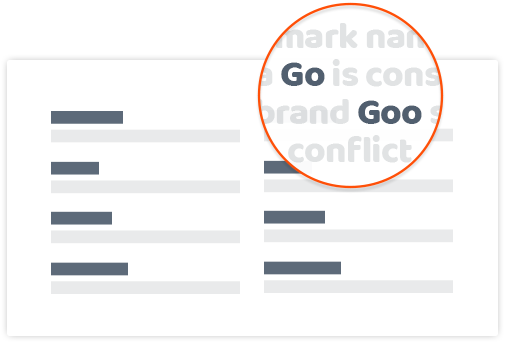Register your name, slogan, or logo today.
File your trademark online in just minutes with the support of experienced attorneys. Starting at $49 + applicable fees.
120,000+ trademarks filed since 2016
35,000+ five-star reviews
Rated 4.8 by Forbes Advisor
Start protecting your business today
Choose the package that best suits your needs and let our experienced legal team guide you through the trademark registration process with professionalism and care.
+ applicable fees
Includes:
Direct-Hit Search of the Federal USPTO Database: Ensure your trademark is unique and available.
Customer Trademark Classification: Using the USPTO’s ID manual, our attorneys will devise a class and description of goods and services that best matches what you seek to protect with your trademark registration.
+ applicable fees
Includes basic package, plus:
One-on-One Consultation with a Trademark Lawyer: 15-minute session to address your specific needs.
Privacy Protection: Keep your personal contact information confidential in the USPTO database
Cease and Desist Letter: Take action against potential infringements
+ applicable fees
Includes standard package, plus:
One-on-One Consultation with a Trademark Lawyer: Extended 1-hour session for in-depth assistance.
Rush Processing: Priority 48-hour processing
Trademark Monitoring infringement alerts (free trial*)
How Trademark Engine Works
Get your trademark registered in just 3 easy steps using our simple online questionnaire.
1. Answer a Few Questions
Regardless of the level of support you desire, we have options to suit your needs. Simply fill out our short questionnaire to get started and an attorney will guide you through the next steps.
2. Compile Application and Search
Our legal support staff will conduct a trademark search to make sure your name, logo, or slogan is available for registration, reducing the risk of rejection.
3. Application Filing
Your completed application will be filed with the U.S. Patent and Trademark Office (USPTO).
Why get a trademark?
Most of the brands, logos and slogans you love, know and trust have been registered. A registered mark gives you a presumption of ownership and a presumed right to use the brand nationwide giving you broader protection in courts. Once registered, present yourself as an established and serious business with the ® symbol after your name, logo or slogan. Other benefits include:
Presumed validity of the mark if you have to sue
Additional remedies in court
May increase the value of your company

Why run a search for similar marks?
Before spending your time and money filing an application, you should do a search to see if your mark is already in use or registered by someone else. A search will help avoid obvious duplications of pre-existing marks. If the USPTO rejects your application, the fees to Trademark Engine and the USPTO are not refundable. If your company is just beginning, it’s better to make name changes now rather than invest in building a brand only to learn that you have to change the name and lose all of your goodwill. All packages include a free, federal direct-hit search. We also offer more comprehensive searches that will include wider searches on the federal, state, common law, and global levels. Enjoy a better peace of mind while your trademark application is pending with the USPTO.

Federal Trademark Registration FAQs
Still have questions? Call 1 (877) 721-4579 or LIVE CHAT with us for real-time support.
One way to understand a trademark is that it is a word, phrase, symbol, and/or design that identifies and distinguishes the source of the goods of one party from those of another party. A “service” mark distinguishes the source of a service, rather than a good, but the two are typically simply referred to as a “trademark” or “mark”. In more general terms, getting a trademark protects a brand. Many of the well-known brands, logos and slogans you love, know and trust have been registered with the United States Patent and Trademark Office.
Generally, the registration of a trademark entitles the registrant to a presumption of ownership of the brand on a national level and a presumed right to use the brand nationwide. It may help prevent someone from registering a confusingly similar mark later and may also help the registrant bring a case in federal court if someone infringes on the brand. Once registered, a registrant can typically start using the ® symbol after the name, logo or slogan.
After a mark is properly registered and used for a five-year period, Trademark Engine can also help file a “Declaration of Incontestability.” Considered by some the greatest protection under U.S. trademark law, this may help prevent others from contesting a trademark on the following grounds: (1) the mark is not inherently distinctive; (2) it is confusingly similar to another mark that someone else began using first; or (3) the mark is simply functional as opposed to identifying the source of the goods or services.
Please also read WHAT YOU MUST KNOW BEFORE USING THIS WEBSITE.
Under U.S. law, a “common law trademark” is generally established when someone uses a company name, logo or slogan in commerce, even if it is not registered. So, why pay to register a trademark when a common law trademark may already exist? Common law rights ordinarily are limited to the geographic area where the mark is used as opposed to the nationwide protection customarily obtained when a mark is registered with the USPTO. So, unless registered, the use of a mark can be geographically limited, which hampers the ability to expand the brand. On the other hand, a person using a mark in a limited geographic area could be boxed in by someone else who offensively registers a similar mark. In addition, registration of a trademark can give the person holding the registered trademark a leg up in court as to the validity of the mark and the date of usage in later trademark infringement litigation, if it comes to that. There are also favorable remedies available to registered trademark owners in the event of litigation. Finally, once a trademark is accepted by the USPTO, it will be maintained in the USPTO database, which can discourage others from using the mark in the future. Future companies should be on notice that the mark is already spoken for, which should in turn help avoid at least some disputes.
There may be advantages to registering both a name and an associated logo. But bear in mind, each filing requires its own application, government filing fees and processing fees to Swyft Legal. Even if you were to apply on your own, it would cost at least $700.
A more budget-friendly option could involve registering just the name trademark. Wrongful use of names seems to be more common than wrongful use of logos. Trademarking a name generally provides broader protection because it prevents any use of the name that causes confusion, even if someone tries to use the name within a unique logo.
A mark for a logo typically protects the shape, orientation, stylization and sometimes color in that particular logo. Registering ordinarily prevents others from using that logo or something confusingly similar to the logo. Even if a company name is in the logo, registering the logo may only protect the use of that name in the particular way it is used in the logo and not the use of the name more generally. Moreover, amended or redesigned logos usually require a new application for the new logo. As may be expected, logo changes seem to be more common than name changes."
Much like how the availability of a corporate name in a given state does not necessarily provide superior trademark rights to use the name in commerce, the availability of the domain name is not an indication either. A company could have a trademark name on a product or service, but not have acquired the domain name.
The availability of the domain name should be one part of a comprehensive search, which Trademark Engine offers, to help evaluate the strength of a brand name or slogan and the likelihood of a trademark being approved.Using a domain name as part of a brand that sells goods or services may establish common law trademark rights. A “common law” trademark can be established when a name, logo or slogan is used in commerce, even if it is not registered. Common law rights, however, are limited to the geographic area where the mark is actually used as opposed to the nationwide protection typically established by registration of a mark with the USPTO.
The geographic limitations of an unregistered mark can make it difficult to expand a business. On the other hand, a person using a mark in a limited geographic area could be boxed in by someone else who offensively registers a similar mark. In addition, registration of a trademark customarily gives the person holding the registered trademark a leg up in court as to the validity of the mark and the date of usage in later trademark infringement litigation, if it comes to that. There are also favorable remedies available to registered trademark owners in the event of litigation. Finally, once a trademark is accepted by the USPTO, it should be maintained in the USPTO database, which can discourage others from using the mark in the future. Future companies should be on notice that the mark is already spoken for, which should in turn help avoid at least some disputes.
General benefits to registering a mark:
- Nationwide protection
- Presumed right to the exclusive use of the mark nationwide
- Presumed validity of the mark in a lawsuit
- Additional remedies in court
- May increase the value of the company
- You can record the mark with the U.S. Customs and Border Protection, which may help stop importation of infringing or counterfeit goods into the U.S.
- The right to use the ® symbol
If investing heavily in a marketing campaign with a slogan, a company might consider registering that slogan in connection with the goods or services they offer well. Like all trademarks, a slogan you wish to register should be inherently distinctive and creative or have developed a secondary meaning. In other words, “really good pizza” probably can’t be trademarked unless that saying has become so famous that most consumers associate it with a certain pizza brand.
Initiating the process will usually take anywhere from 5 to 10 minutes on the Trademark Engine website. For a typical application, be prepared to provide at least the following:
- The actual mark you want to use.
- The full legal name and address of the owner of the mark.
- (If your mark is ""In Use"") A copy of the specimen which is an example that shows you are using the mark in commerce. This could be a picture of your product or a website advertising your service.
- A category of the goods or services where you are using your mark from our drop down menu and a description of your goods or services.
- (If your mark is ""In Use"")The date you first used the mark in commerce and the date you first shared the mark anywhere."
*The law firm responsible for the portion of this page constituting an advertisement is Swyft Legal, LLC who can be reached at [email protected]. Swyft Legal, LLC is licensed by the Arizona Supreme Court under license number 70173. All legal services provided in connection with the attorney-led trademark process are provided by Swyft Legal, LLC. Trademark Engine is an affiliate of Swyft Legal, LLC.
*After a 7-day free trial, your Brand Protection+ subscription will automatically renew at $199 annually.
*After a 10-day free trial, your Trademark Monitoring subscription will automatically renew for $175 quarterly.
*The USPTO federal government application fee is $350 per class. The USPTO requires an additional $200 per class if entries from the Trademark ID manual are not used to describe the goods and services protected by the registration. Trademark Engine charges a $60 platform fee to users who either are placing an order for the first time, are return users who have never been charged a platform fee, or are users who previously paid the platform fee but have not placed an order in over two years.”
Take action to protect your name today.
Thousands have protected their brand by filing a trademark.
Trademark Engine provides information and software only. Trademark Engine is not a "lawyer referral service" and does not provide legal advice or participate in any legal representation. Use of Trademark Engine is subject to our Terms of Service and Privacy Policy.



